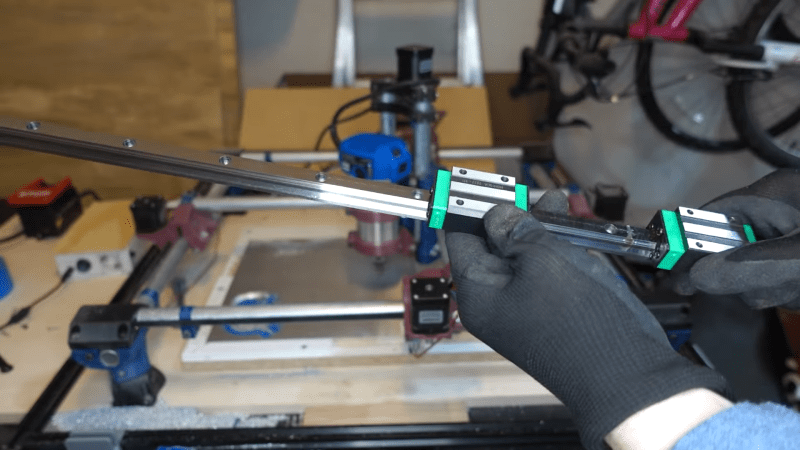The Mostly Printed CNC is famous for two things. First, being made mostly from 3D printed parts and commonly available steel tubing. Second, because of the materials used, its rigidity isn’t fantastic. But any CNC router is better than no CNC router, and [Alan Reiner]’s “Mostly Mostly Printed CNC” upgrades the base MPCNC into a much more capable unit.
MPCNC purists may want to look away, as the video below shows [Alan] committing the heresy of adding linear rails to his machine. The rails were sourced from VEVOR and at less than $100 for 10 meters, it must have been hard to resist. The rigidity wasn’t amazing — witness the horrific chatter at around the 5:15 mark — but [Alan] sorted that out with some aluminum extrusion and printed adapters.
Those upgrades alone were enough to let [Alan] dive into some aluminum cutting, but he also wanted to address another gripe with his base build: the Z-axis backlash. The fix there was to add another lead screw nut on an adjustable carrier. By tweaking the relative angles of the two opposed nuts, almost all of the backlash was taken up. [Alan] also replaced the motor coupling on the Z axis with a Lovejoy-style coupler, to remove as much axial compliance as possible.
Along with the motion control mods, [Alan] improved work holding and added an enclosure to tame the chip beast, along with some upgrades to the control electronics. The results are pretty good and appear well worth the modest added expense. Maybe a wireless controller can be next on the upgrade list?

















For some reason the machines that are capable of milling aluminium or other hard materials are heavy and stiff.
The tiny resonance, slack, or softness in machine body causes the end mill to vibrate which again amplifies the problems. Only way out is to make the machine actually stiff. I think we should forget the 3D printed parts for this kind of applications.
I think 3d printed parts are good for bootstrapping. Means use them to build a CNC which you use to rebuild these by milling them out of better materials.
Aluminum isn’t a hard material. It’s quite soft actually, which is why most not-so-heavy-and-stiff machine can actually handle it.
My home machine is made out of some linear rails and 6mm plywood. It’s not stiff at all. But I can mill Aluminum. Accuracy isn’t the best (0.1mm) but that isn’t an issue for the things I make with it, as it is quite big at 1500mm and mostly use it for wood. And the whole machine only set me back 600 euro (of which a big chunk is the router itself)
“Mostly Printed CNC” is a quite bad design. Frankensteining some MGR15 rails into it does not make it much better.
If you’re interested in this type of light machine, then have at least a look at Print NC. Print NC is still a lightweight ( and thus not very stiff) machine, but with the rectangular steel tubes it is starting to become decent. There is also a quite large / active community around it.
https://wiki.printnc.info/en/home
https://threedesign.store/printnc/
And of course, as a DIY machine you can customize it to your liking. I even believe there are parametric drawings available so you can adjust the 3D printed parts for different sizes rectangular tubing (How big do you want / dare to go?) One upgrade I would certainly do, is to buy the BK bearing blocks with the built in motor flanges in one piece. These circumvent a lot of aligning headaches, and they are not very expensive, compared to a bearing block and motor flange.
+1 for print NC as bootstrap CNC, it’s also better/stiffer than most of the aluminium extrusion type CNCs like OpenBuilds CNC machines using thin belts and delrin rollers on alu extrusion rails. One of the biggest issues is the gantry torsion stiffness, or the lack thereof.
Inb4 the mpcnc creator Coles after him.
https://www.youtube.com/watch?v=68ohaPYyiDA
I like the way open source hobbyist and commercial developments have mingled and mixed as 3d printing has developed.
I have no current ambitions regarding starting a business myself. But I was still turned off by the non-commercial licensing of the MPCNC.
(OP) For everyone commenting about “just build a PrintNC to cut aluminum” … I kinda agree with you! I love my MPCNC, and I think it’s a surprisingly good, high value, DIY machine for cutting wood. It’s way better than you would expect given the weird combination of components and printed parts it uses.
I built it because I didn’t want to spend a lot of money on a CNC machine, to find out that CNC machines are too big/loud/annoying to keep in my tiny garage. Once I determined it was workable, I didn’t really want to start over with a new machine. So I thought it would be a fun challenge to try to upgrade it. And it was fun. And I’m quite happy with it.
THAT SAID, if I were to start from scratch, knowing that cutting (soft) metals is a high priority, I almost definitely would’ve gone with the PrintNC. MPCNC is designed to be a kind of inexpensive, minimalist design to survive the stresses of CNC routing wood. The fact I got it working with metal (even before the upgrades) is kind of a stretch, but doable with enough TLC. OTOH, PrintNC is *designed* to be a minimal machine that can cut metal. Rigid steel tube framing, proper linear rails all around, etc. You’re going to spend more to go down that path, but if you plan to chew up aluminum/brass/etc on a regular basis, I would consider PrintNC to be the kind of “minimal” DIY machine for that.